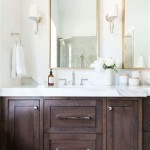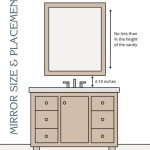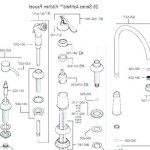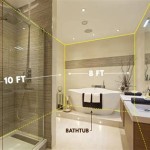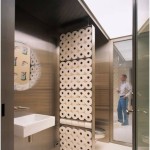How to Replace a Bathroom Mirror Medicine Cabinet
Replacing a bathroom mirror medicine cabinet is a straightforward project that can significantly enhance the look and functionality of your bathroom. Whether your current cabinet is outdated, damaged, or simply doesn't meet your storage needs, this step-by-step guide will equip you with the necessary knowledge and skills to tackle the task successfully.
1. Gather the Necessary Tools and Materials
Before embarking on the replacement process, ensure you have all the required tools and materials readily available. This will streamline the project and prevent unnecessary delays. Here's a comprehensive list:
- New bathroom mirror medicine cabinet
- Screwdriver (Phillips head and flathead)
- Level
- Measuring tape
- Pencil
- Drill with appropriate drill bits
- Stud finder
- Safety glasses
- Work gloves
- Caulk gun
- Silicone sealant
- Drywall anchors (if necessary)
- Ladder (if needed)
It's essential to select a mirror medicine cabinet that complements the style and dimensions of your bathroom. Consider factors such as size, finish, and storage capacity to ensure a harmonious integration with your existing décor.
2. Remove the Old Medicine Cabinet
The first step involves carefully removing the old medicine cabinet. This process may vary depending on the cabinet's design and installation method. Here's a general procedure:
- Disconnect Power: If the medicine cabinet has electrical components, such as a light fixture, turn off the power supply at the breaker box.
- Remove Cabinet Contents: Empty the medicine cabinet of all its contents to prevent damage during removal.
- Locate Mounting Points: Identify the screws or fasteners holding the cabinet in place. They are typically located on the sides and/or bottom of the cabinet.
- Remove Fasteners: Use a screwdriver to carefully remove the screws or fasteners. Be cautious to avoid damaging the surrounding wall surface.
- Gently Pull Away: Once all fasteners are removed, gently pull the cabinet away from the wall, being mindful of any wires or plumbing connections.
- Remove Mounting Plate: If the cabinet has a separate mounting plate, remove it from the wall using the same procedure.
Once the old medicine cabinet is removed, inspect the wall for any damage or imperfections that require repair before proceeding to the next step.
3. Prepare the Wall and Install the New Cabinet
After removing the old cabinet, you'll need to prepare the wall for the new installation. This involves cleaning the wall surface and ensuring it's level:
- Clean Wall Surface: Thoroughly clean the wall area where the new cabinet will be mounted. Use a damp cloth to remove dust, dirt, and any adhesive residue from the old cabinet.
- Level the Wall: Use a level to ensure the wall surface is perfectly level. This is crucial for a professional-looking installation.
- Locate Studs: Using a stud finder, locate the wall studs where the new cabinet will be mounted. Securely attaching the cabinet to studs will provide maximum stability and support.
- Mark the Wall: Using a pencil, mark the positions on the wall where the new cabinet will be installed, aligning it with the level marks and stud locations.
- Pre-Drill Holes (If Necessary): If the new cabinet's mounting screws are larger than the wallboard thickness, pre-drill holes to prevent splitting the drywall.
Once the wall is prepared, proceed with installing the new medicine cabinet. Consult the manufacturer's instructions for specific details and recommendations for your chosen model.
- Mount the Cabinet: Position the new cabinet against the wall, aligning it with the marked locations. Secure the cabinet to the wall using appropriate screws or fasteners. Ensure a firm and secure connection.
- Level and Adjust: Use a level to ensure the cabinet is perfectly level. Make any necessary adjustments before tightening the mounting screws completely.
- Secure with Additional Fasteners: For extra stability, consider using additional screws or fasteners to secure the cabinet to the wall. This is especially important if the cabinet is heavy or will be subjected to frequent use.
- Seal Joints: Apply silicone sealant around the edges of the cabinet where it meets the wall. This will create a water-resistant seal and prevent moisture damage.
After the installation is complete, re-connect the power supply if necessary and ensure the cabinet is functioning properly. Remember to discard the old cabinet and its packaging according to local recycling guidelines.

How To Install A Medicine Cabinet The Home Depot

Diy Niche Shelf Old Bathroom Medicine Cabinet Makeover A Piece Of Rainbow

Bathroom Medicine Cabinet Mirror Replacement Doityourself Com Community Forums

How To Install A Mirrored Medicine Cabinet Vanity Light

Medicine Cabinets Ideas 7 Diy Updates Bob Vila

How To Remove A Medicine Cabinet Kay S Place

How To Turn A Mirror Into Medicine Cabinet Diy Bathroom

Medicine Cabinets Ideas 7 Diy Updates Bob Vila

Diy Niche Shelf Old Bathroom Medicine Cabinet Makeover A Piece Of Rainbow

How To Update A Medicine Cabinet Without Replacing It This Diy Life
Related Posts

